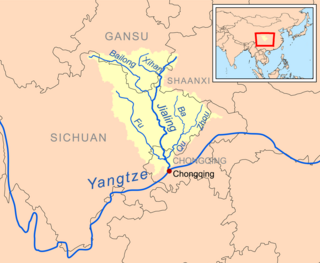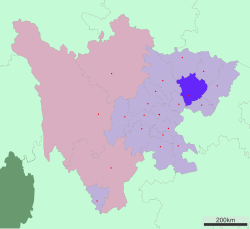
Sichuan is a province in Southwestern China, occupying the Sichuan Basin and Tibetan Plateau—between the Jinsha River to the west, the Daba Mountains to the north, and the Yunnan–Guizhou Plateau to the south. Its capital city is Chengdu, and its population stands at 83 million. Sichuan neighbors Qinghai and Gansu to the north, Shaanxi and Chongqing to the east, Guizhou and Yunnan to the south, and Tibet to the west.

Yichang, alternatively romanized as Ichang, is a prefecture-level city located in western Hubei province, China. Yichang had a population of 3.92 million people at the 2022 census, making it the third most populous city in Hubei. The city is famous for the Three Gorges, the Three Gorges Dam and the Gezhouba Dam, all three of which are located in Yiling District, one of the city's districts.

Ankang is a prefecture-level city in the south of Shaanxi Province in the People's Republic of China, bordering Hubei province to the east, Chongqing municipality to the south, and Sichuan province to the southwest. It covers an area of 23,391 square kilometres (9,031 sq mi) and consists Xunyang, a county-level city, one urban district, and eight counties. Its total population was 2,493,436 people according to the 2020 Chinese census, with 1,244,784 living in urban areas.

Mianyang is the second largest prefecture-level city of Sichuan province in Southwestern China. Located in north-central Sichuan covering an area of 20,281 square kilometres (7,831 sq mi) consisting of Jiangyou, a county-level city, five counties, and three urban districts. Its total population was 4,868,243 people at the 2020 Chinese census, of whom 2,232,865 live in its built-up area made of three urban districts.

The Jialing River, formerly known by numerous other names, is a major tributary of the Yangtze River in the Sichuan Basin. It is named after the Jialing Valley in Feng County, Shaanxi through which it flows.

Suining (simplified Chinese: 遂宁; traditional Chinese: 遂寧; Sichuanese Pinyin: Xu4nin2; Sichuanese pronunciation: ; pinyin: Sùiníng; Wade–Giles: Sui-ning) is a prefecture-level city of eastern Sichuan province in Southwest China. According to the 2020 census, Suining had a population of 2,814,196, with 1,612,641 living in built up(or metro) areas.

Leshan, formerly known as Jiading and Jiazhou, is a prefecture-level city located at the confluence of the Dadu and Min rivers, on the southwestern fringe of the Sichuan Basin in southern Sichuan, about 120 km (75 mi) from the provincial capital of Chengdu. As of the 2020 census, its population was 3,160,168, of whom 1,236,188 lived in the built-up metro area made of Shizhong (downtown), Wutongqiao, Shawan and Jinkouhe districts. A historical and cultural city, Leshan is famous for world heritage sites Emei Mountain and Leshan Buddha. It is also a regional center in the southern part of the Chengdu Economic Zone, serving as a transportation hub and port city in southwestern China.

Langzhong is a county-level city in northeastern Sichuan province, China, located on the middle reaches of the Jialing River. It is administered as part of the prefecture-level city of Nanchong. Langzhong has a total population of 622,667, with 303,044 residing in the urban area in 2020.

Guangyuan is a prefecture-level city in Sichuan Province, China, bordering the provinces of Shaanxi to the northeast and Gansu to the northwest. The city has a population of 2,305,657 as of the 2020 census.

Dazhou is a prefecture-level city in the northeast corner of Sichuan province, China, bordering Shaanxi to the north and Chongqing to the east and south. As of 2020 census, Dazhou was home to 5,385,422 inhabitants whom 1,850,869 lived in the built-up area made of 2 urban districts.

Bazhong is a prefecture-level city in north-eastern Sichuan province, China. Its population was 2,712,894 at the 2020 census whom 1,064,766 lived in Bazhou and Enyang urban districts. As of the end of 2022, the resident population of Bazhong City was 2,658,800 people.

Pengzhou, formerly Peng County or Pengxian, is a county-level city of Sichuan Province, Southwest China, it is under the administration of the prefecture-level city of Chengdu. There is an expressway that connects Pengzhou to Chengdu. It is bordered by the prefecture-level divisions of Deyang to the northeast and the Ngawa Tibetan and Qiang Autonomous Prefecture to the north.

The Roman Catholic Diocese of Shunqing, also known as Diocese of Nanchong, is a suffragan Latin Catholic diocese in the ecclesiastical province of Chongqing in southwestern China, yet depends on the missionary Roman Congregation for the Evangelization of Peoples.

Lueyang County, or Lüeyang County, is a county of Hanzhong, in the southwest of Shaanxi province, China, bordering Gansu province to the north and west and located on the upper reaches of the Jialing River. It was first founded in 111 BC. As a result of the 2008 Sichuan earthquake, 95% of buildings in the county seat were damaged. In August 2020, the county seat was flooded by the Jialing River.

Cangxi County is a county of northeastern Sichuan Province, China, located along the upper reaches of the Jialing River. It is under the administration of Guangyuan City. The population in 2020 was 512,617.

Xichong County is a county in the northeast of Sichuan Province, China. It is under the administration of the prefecture-level city of Nanchong.

Shunqing District is a district of Nanchong city, Sichuan Province, China.
The COVID-19 pandemic reached the province of Sichuan, People's Republic of China on 20 January 2020, with its first case confirmed on the next day.
Nanchong North railway station is a railway station in Shunqing District, Nanchong, Sichuan, China. It is an intermediate stop on the Chongqing–Lanzhou railway and operated by China Railway Chengdu Group.

Nanchong Senior High School (四川省南充高级中学) is a public high school in Nanchong City, Sichuan Province. The school comprises five campuses—Shunqing, Jialing, Gaoping, Linjiang, and Wenfeng—covering approximately 184 acres. The school has 1,336 staff members, including 406 with senior titles, and 34% of the teachers hold graduate-level qualifications.
























